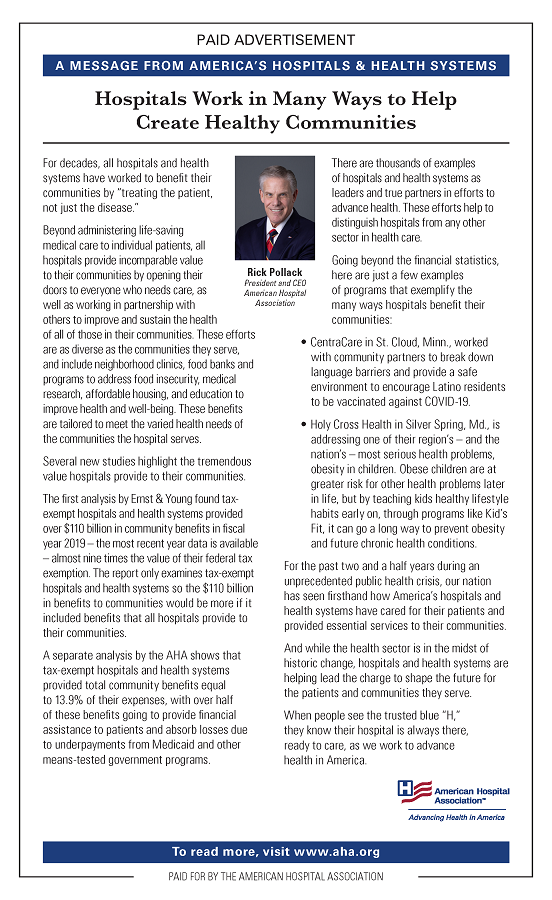

Hospitals Work in Many Ways to Help Create Healthy Communities
A Message from America's Hospitals & Health Systems
Paid Advertisement Appearing in the Wall Street Journal
August 1, 2022
For decades, all hospitals and health systems have worked to benefit their communities by “treating the patient, not just the disease.”
Beyond administering life-saving medical care to individual patients, all hospitals provide incomparable value to their communities by opening their doors to everyone who needs care, as well as working in partnership with others to improve and sustain the health of all of those in their communities. These efforts are as diverse as the communities they serve, and include neighborhood clinics, food banks and programs to address food insecurity, medical research, affordable housing, and education to improve health and well-being. These benefits are tailored to meet the varied health needs of the communities the hospital serves.
Several new studies highlight the tremendous value hospitals provide to their communities.
The first analysis by Ernst & Young found tax-exempt hospitals and health systems provided over $110 billion in community benefits in fiscal year 2019 – the most recent year data is available – almost nine times the value of their federal tax exemption. The report only examines tax-exempt hospitals and health systems so the $110 billion in benefits to communities would be more if it included benefits that all hospitals provide to their communities.
A separate analysis by the AHA shows that tax-exempt hospitals and health systems provided total community benefits equal to 13.9% of their expenses, with over half of these benefits going to provide financial assistance to patients and absorb losses due to underpayments from Medicaid and other means-tested government programs.
There are thousands of examples of hospitals and health systems as leaders and true partners in efforts to advance health. These efforts help to distinguish hospitals from any other sector in health care.
Going beyond the financial statistics, here are just a few examples of programs that exemplify the many ways hospitals benefit their communities:
- CentraCare in St. Cloud, Minn., worked with community partners to break down language barriers and provide a safe environment to encourage Latino residents to be vaccinated against COVID-19.
- Holy Cross Health in Silver Spring, Md., is addressing one of their region’s – and the nation’s – most serious health problems, obesity in children. Obese children are at greater risk for other health problems later in life, but by teaching kids healthy lifestyle habits early on, through programs like Kid’s Fit, it can go a long way to prevent obesity and future chronic health conditions.
For the past two and a half years during an unprecedented public health crisis, our nation has seen firsthand how America’s hospitals and health systems have cared for their patients and provided essential services to their communities.
And while the health sector is in the midst of historic change, hospitals and health systems are helping lead the charge to shape the future for the patients and communities they serve.
When people see the trusted blue “H,” they know their hospital is always there, ready to care, as we work to advance health in America.


